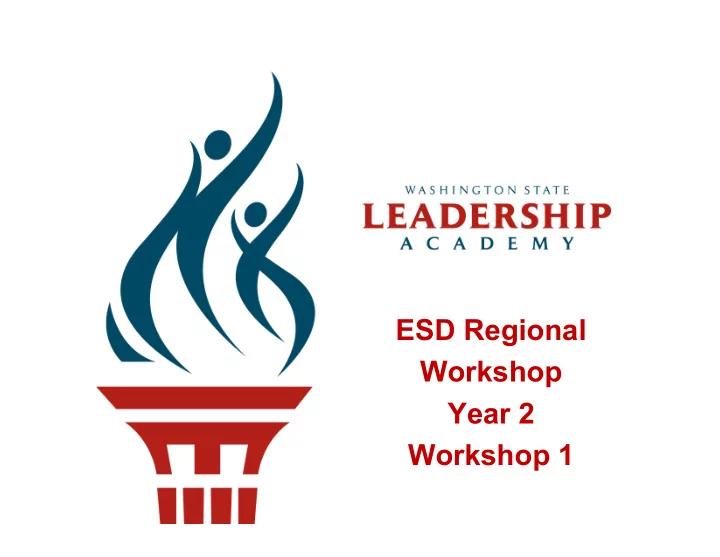

ESD Regional Workshop Year 2 Workshop 1
WSLA Year 2 u u Workshop 1
WSLA Curriculum Strands
GOALS for the day: • Refresh the leadership focus needed for the implementation of the Academy work in Year 2 • Continue to examine the implementation of your Theory of Action and relation to Instructional Core • Deepen understanding of the Problem of Practice , Theory of Action , Evidence of Progress and Cycle of Inquiry and their relationship to your work • Determine your team ’ s growth from WSLA Year 1
NORMS We Will: • Always treat each other with respect • Actively listen to each other • Encourage everyone to fully participate • Be respectful of each other’s time and perspectives • Stay focused, involved and productive • Be committed to be here ready to work – on time and with little distraction • Find ways to celebrate successes • Have fun and enjoy the time with our peers
WSLA Problem of Practice How can we create and lead a system that ensures effective instruction for all students, integrates multiple initiatives—i.e., Common Core, TPEP, Smarter Balanced—and results in sustained high levels of learning?
Focusing Handout p. 4 Answer the following questions: • What do you hope to accomplish this year? • How does the work you hope to accomplish align with the data you and your colleagues have reviewed in developing your Theory of Action? • Why is the work you will be doing this year the right focus for your district?
What growth have you made? In your district teams: 1. Review where you placed yourself on the WSLA Rubrics last Spring 2. Determine if you are still in that same place or any movement made 3. List the steps you will need to take this year to move forward on the rubrics
Force Field Analysis Brainstorm Rate 1-4 Compare Decide What steps do you need to take this year to move forward—your desired state?
What growth have you made? • Be prepared by 10:45 to share your growth with others • Take a break when needed
Sharing with Colleagues
Instructional Core Teacher Task Student Content
Instructional Core • Principle 1: The first principle of instructional improvement is that increases in student learning occur only as a consequence of improvements in the level of the content, teachers ’ knowledge and skill and student engagement http://www.edu.gov.on.ca/eng/policyfunding/leadership/highlights.html
Instructional Core • Principle 2: The second principle of instructional improvement follows from the first: If you change any single element of the instructional core, you have to change the other two to affect student learning.
Instructional Core • Principle 3: The third principle of instructional improvement: If you can ’ t see it in the core , it is not there
Instructional Core • Principle 4: The fourth principle of instructional improvement is that: The Task Predicts Performance
Instructional Core • Principle 5: The connection between doing the right thing and knowing the right thing to do leads to the fifth principle: the real accountability system is in the tasks that students are asked to do
Instructional Core • Principle 6: We learn to do the work by doing the work , not by telling other people to do the work, not by having done the work at some time in the past, and not by hiring experts who can act as proxies for our knowledge about how to do the work
Instructional Core • Principle 7: This leads to the seventh principle: Description before analysis Analysis before prediction Prediction before evaluation
Theory of Action • Theory of Action – A theory of action is an if… then statement that examines your theory of what you are going to do to get the results that you want to achieve. Elmore discusses the characteristics and qualities of an effective theory of action. Clip #6 http://www.media.gov.on.ca/69056422c44a794a/en/videos/mobile.mp4 • In Pencil • Cheap Paper • Draft Paper • LASER AND LIGHTBULB
Team Time • How does the Instructional Core (IC) affect our work and how does the IC directly apply to the Regional POP and our District ’ s TOA? • What evidence do we have that we are focusing on the Instructional Core? • Do we have the right steps in our TOA to make a significant difference in the learning for all of our students? • What else do our staff members need to learn?
BREAK
The Cycle of Inquiry Understand Start with a What Problem of Happened Practice Develop a Take Systems- Action Level Plan & Theory of Action Identify Evidence of Progress (Copland, ¡2009) ¡
Evidence • What evidence are we looking for? • Who will be looking for the data? When? • Who will be analyzing/interpreting the information? When? • How will we share the results of what is found with others: the board, community and staff?
Homework Assignment for next session: • Connect TOA to the regional POP and communicate your plan to your community. • Develop a communication plan to present next session. • How will you use this to inform, streamline or integrate with other required work.
Reflection In Your WSLA Journal: • What did I learn today? • In what ways has your team grown from today’s work?
Closure “ Without continual growth and progress, such words as improvement, achievement, and success have no meaning. ” Benjamin Franklin
Before You Leave • Please complete evaluation form and give the form to the instructors • Schedule time with your team to complete your Homework • Next WSLA Workshop: November 17, 2015
Recommend
More recommend